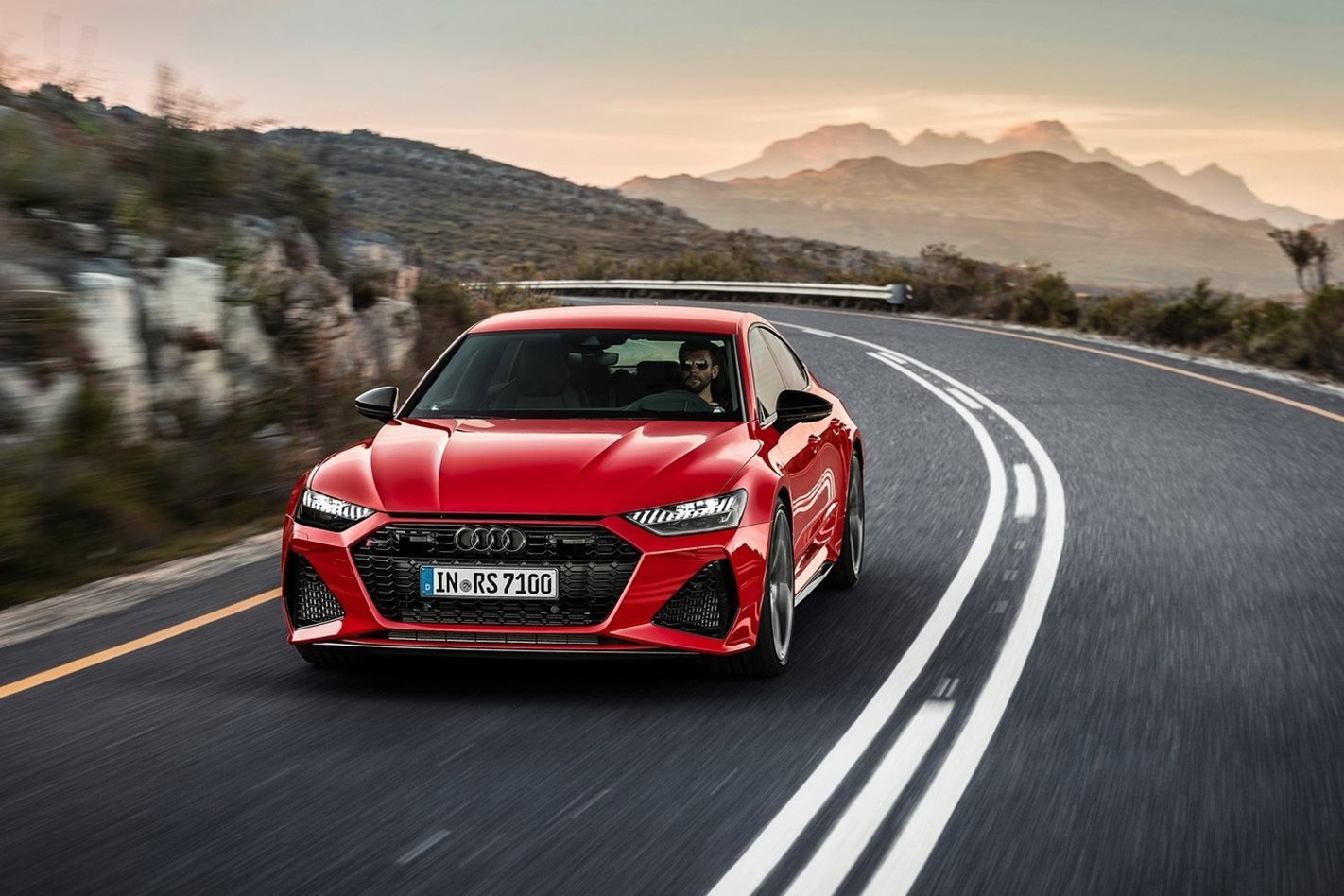
There’s something so damn admirable about Audi’s decision to only offer its RS4 and RS6 high-performance flagships in wagon-only Avant variety. It’s a strategy that started back in 1994 with the RS2 Avant – a sensible Audi 80 wagon that had a 232kW turbo five-cylinder under the bonnet.
The RS2 defined the hot wagon equation and that philosophy continued through the German carmaker’s model lines to today, but at a point along the way, Audi realised the wagon segment was perhaps a little esoteric and an intercostal muscular model might capture a few more fans – especially in Australia where wagons have long fallen out of favour.
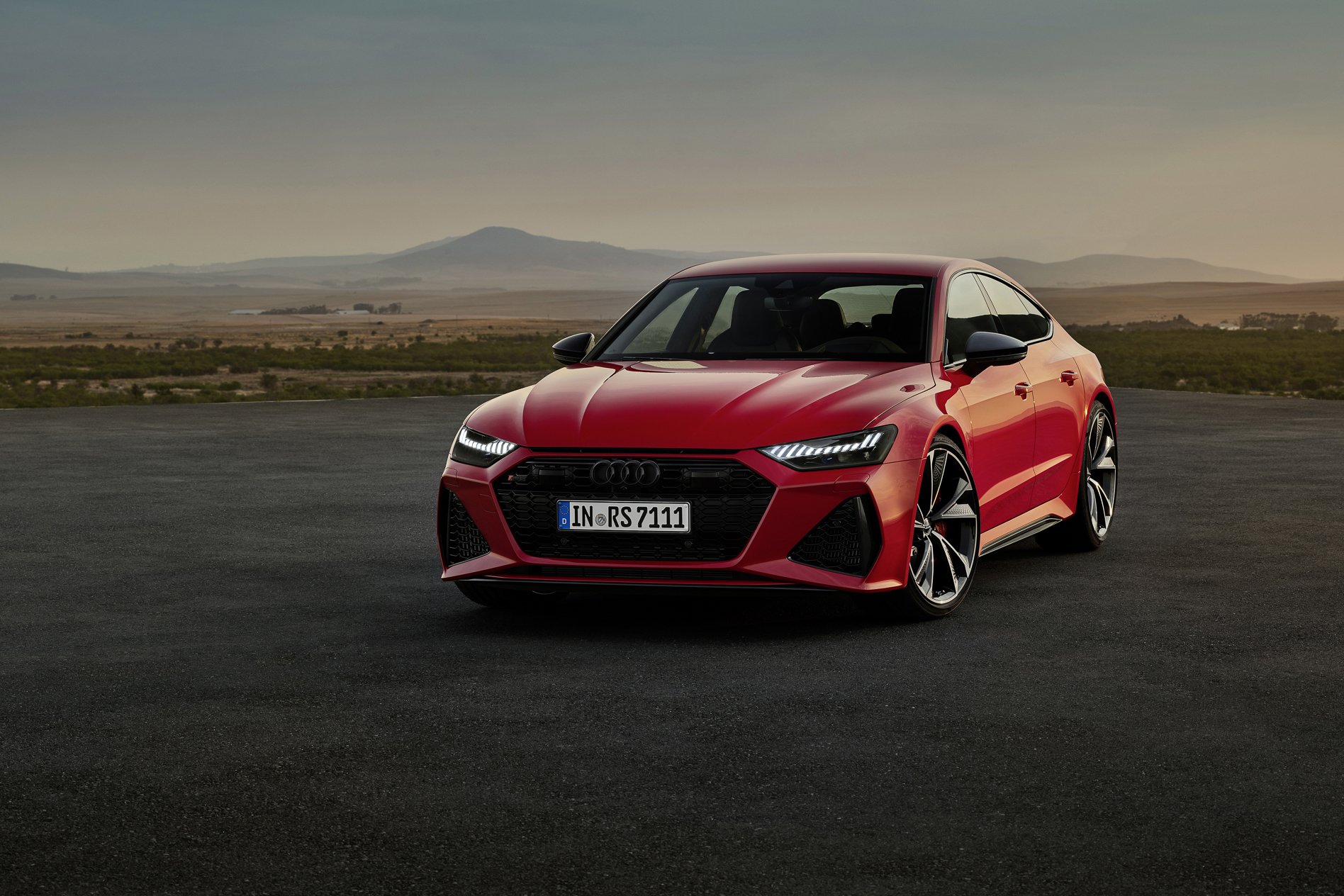
If that applies to you, but the current-generation Audi RS6 Avant’s performance promise makes you a little weak at the knees, then it has a sibling that might fit the bill. Don’t let the badge deceive you, because the RS7 shares exactly the same 441kW turbo V8, quattro all-wheel drive transmission as the Avant, packaged in a very different body.
Exactly what one might call that body is subjective and open to interpretation, but for the record, Audi has dubbed it the Sportback. If it was listed by the Smithsonian, it might define it along the lines of ‘four sedan doors and the boot of a hatchback knitted together by a coupe’s profile’.
And if you think it works well in the pictures, then let us tell you its aggressive stance and intimidating presence works even better in person. Like the RS6, its arches have been fattened by 20mm each side and the aerodynamic work front and rear works aesthetically too.
Expect to see this beast arriving in Australia about the middle of 2020 and priced about the quarter of a million mark, but we got an early glimpse in Germany. Just the day after its official reveal at the 2019 Frankfurt Motor Show, we were thrown the keys and pointed in the direction of the 50-year old Das Hardburg hill climb race.
It takes mere minutes to realise you are in a very special Audi. The RS7’s cabin is typical Ingolstadt attention to detail, beautifully restrained design and purity.
The seats are expertly appointed in fine materials including Alcantara and the minimalist dash layout is striking. Just a single knob protrudes from an otherwise vast expanse of glossy touch screens like a yacht on Lake Eyre.
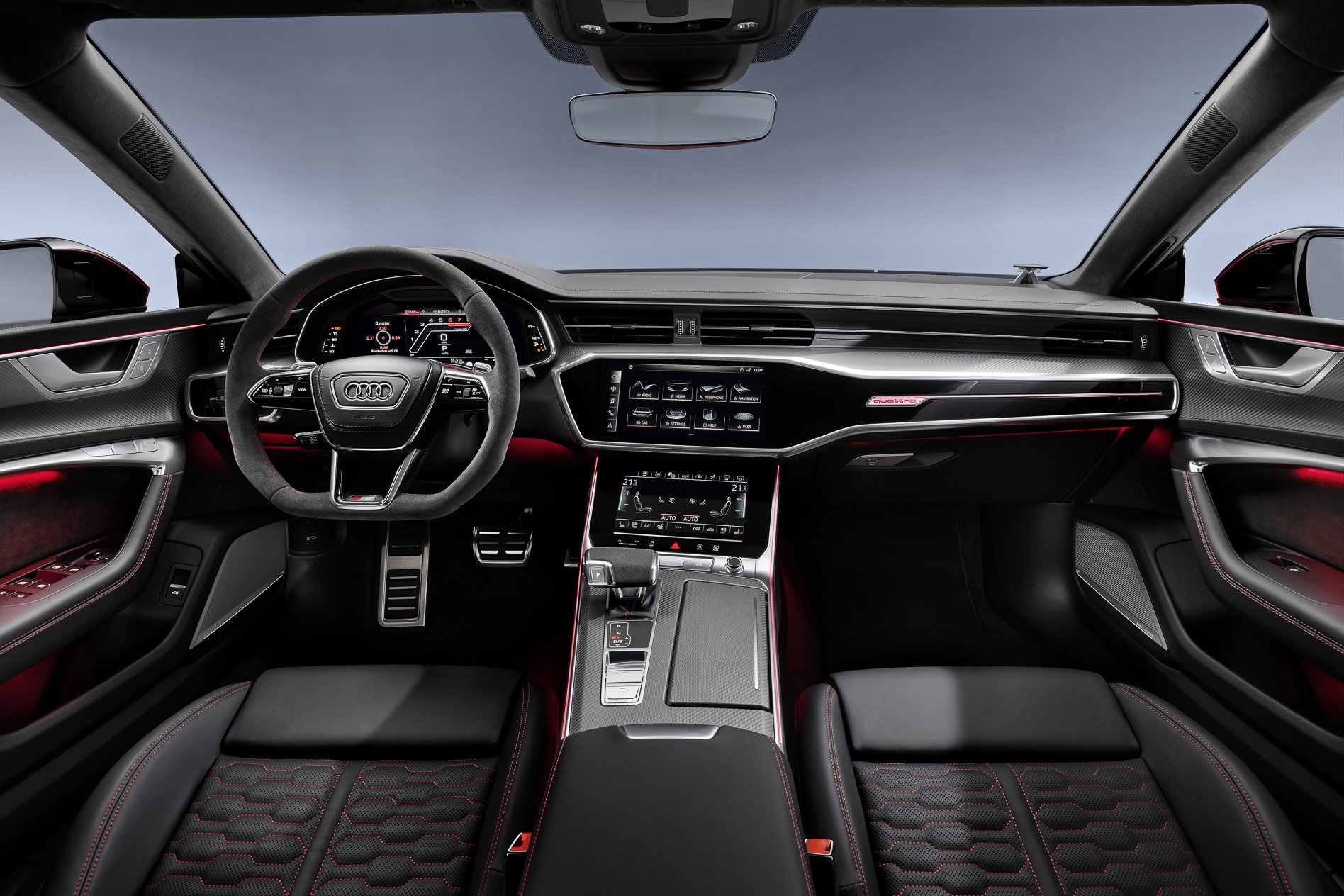
But unlike some other manufacturer’s approach to switchgear rationalisation, which can be tiresomely convoluted – we’re looking at you Lexus – the Audi system is simple and intuitive. The Audi MMI is every bit as sharp and logical as BMW’s iDrive approach.
It would be easy to get lost in the multitude of customisation options including ambient lighting colours, sophisticated personalisation and the excellent Virtual Cockpit digital instrument cluster, but the road out of Frankfurt soon turns to the coveted Autobahn.
On the Autobahn
It’s here that the full might of the RS7 starts to become apparent. At the first sign of a clear straight, the taps are opened allowing the full 800Nm to find its way to the road and the pace increases with eye-popping urgency. Zero to 100km/h arrives in a claimed 3.6 seconds, and as it continues to accelerate the head-up display counts up past 200km/h like a slot machine that’s hit the jackpot, with the cabin serenity defying how quickly the German scenery is flashing past.
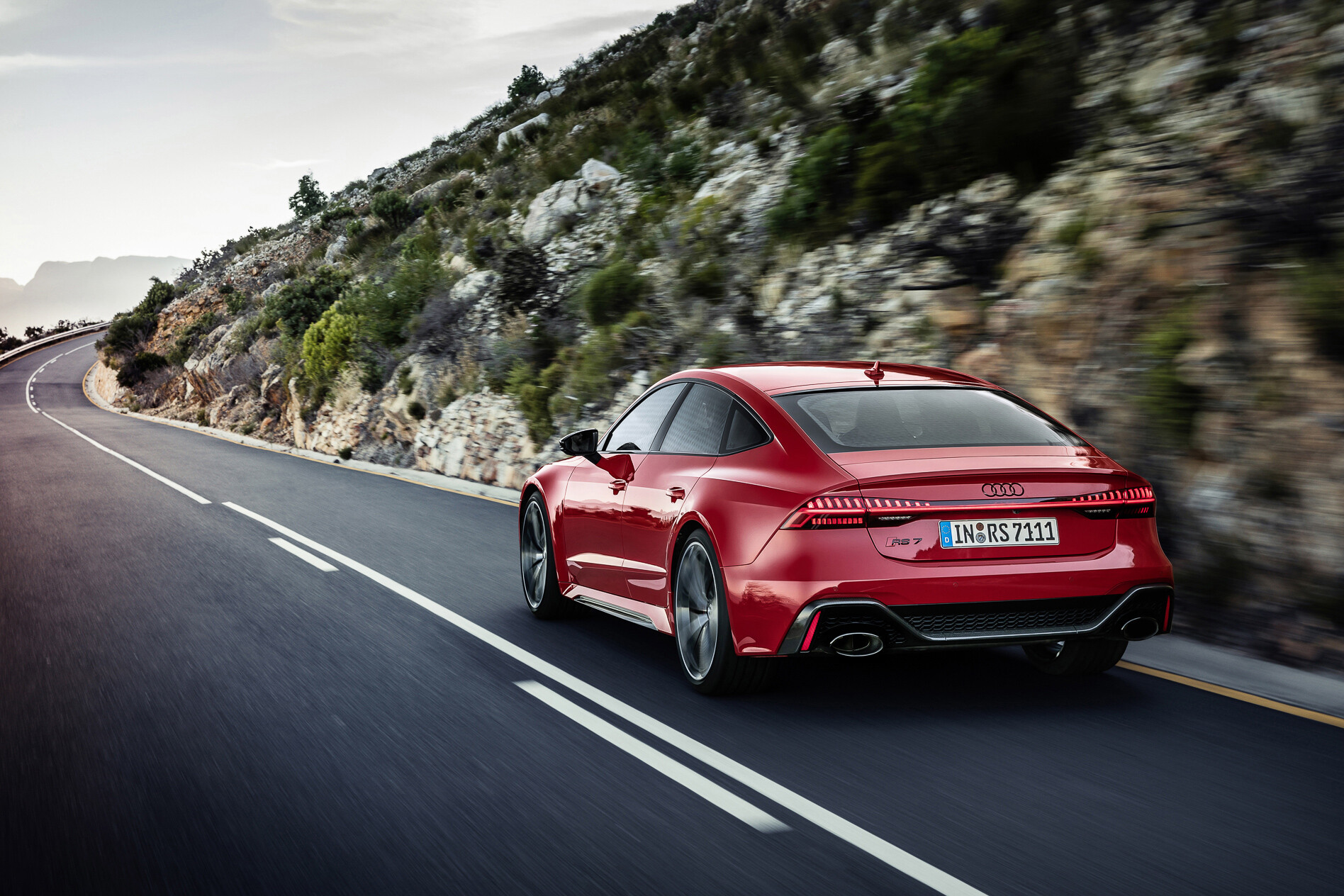
The steering is firm, the nose planted, and the body hunkered into a ridiculously stable stance. Only as 250km/h comes and goes, do the wing mirrors start to roar and indicate our speed.
A car on the horizon pulls into the outside lane and a mission to the magic 300km/h is aborted. An initial smooth rollout of the throttle rapidly turns into a heavy application of brake as we bear down on the initially distant Passat with almost alarming pace. It’s another illustration of just how fast this thing goes.
Fortunately, the trip back from a new PB of 292km/h is as effortless as the excursion to it, thanks to massive carbon-ceramic brakes in all four corners. At the front end, the discs are grabbed by 10-piston callipers courtesy of Brembo and their efficiency is simply staggering.
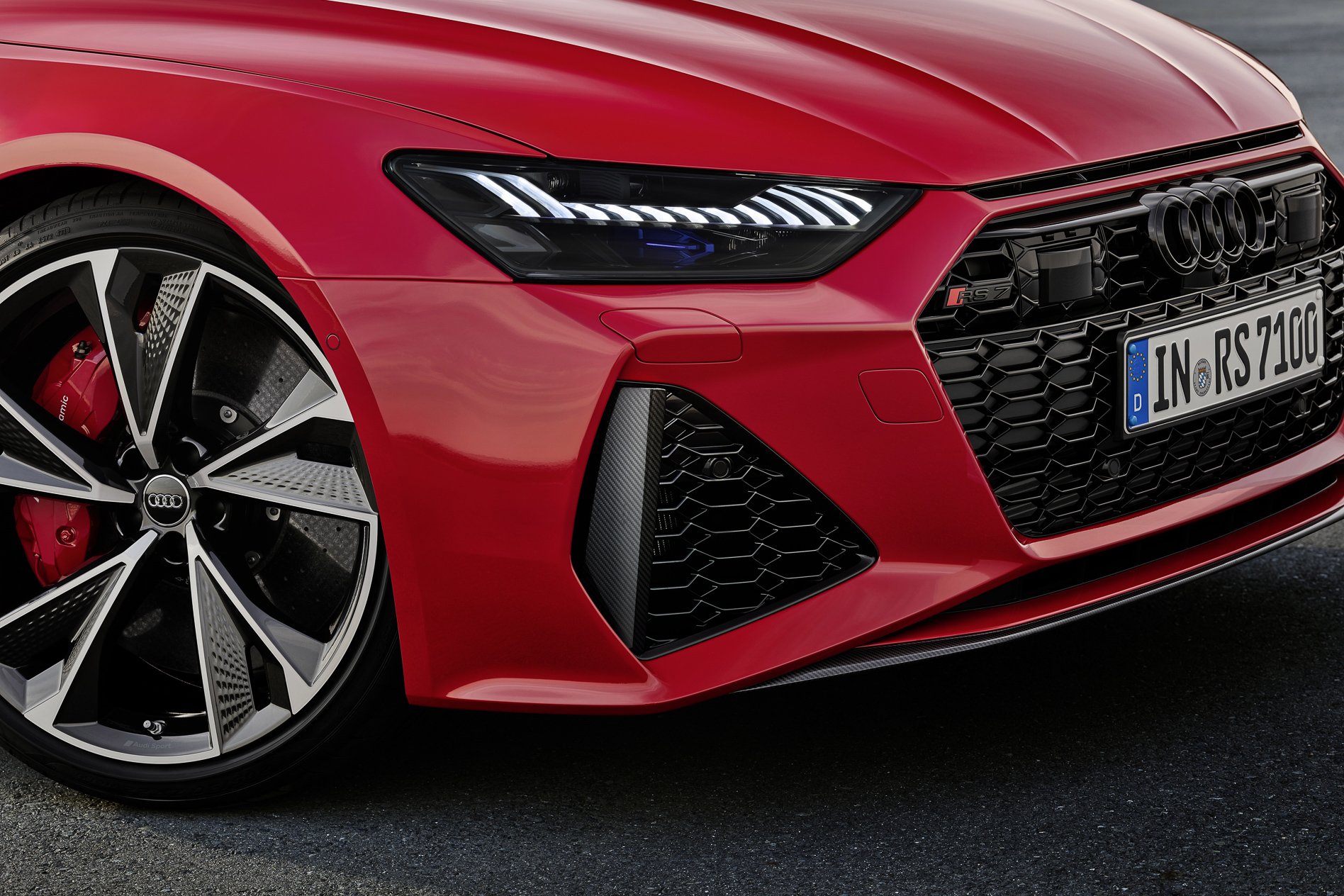
Officially, the RS7 is limited to 305km/h, but from the rate at which it smashed through the various milestones on the way there, it’s obvious it has plenty more pace beyond that. As stunning as the ability to accelerate is the Audi’s stopping power and the confidence to shed speed instils confidence to use its full performance repertoire. Perfect as the way ahead turns hilly.
New peaks
The Das Hardburg hill climb has been running since the 1960s and the 2019 competition ran just two weeks before our arrival. Car nuts keep returning to this German motoring mecca for its beautifully maintained roads that slice through quintessentially pretty countryside and verge on arcadia.
At first, the narrow roads bordered by nasty looking kerbs feel claustrophobic and restrictive of a car like the RS7, but the performance is so accessible. The monstrous acceleration is very easy to get used to and its dimensions seem to shrink as the speeds increase.
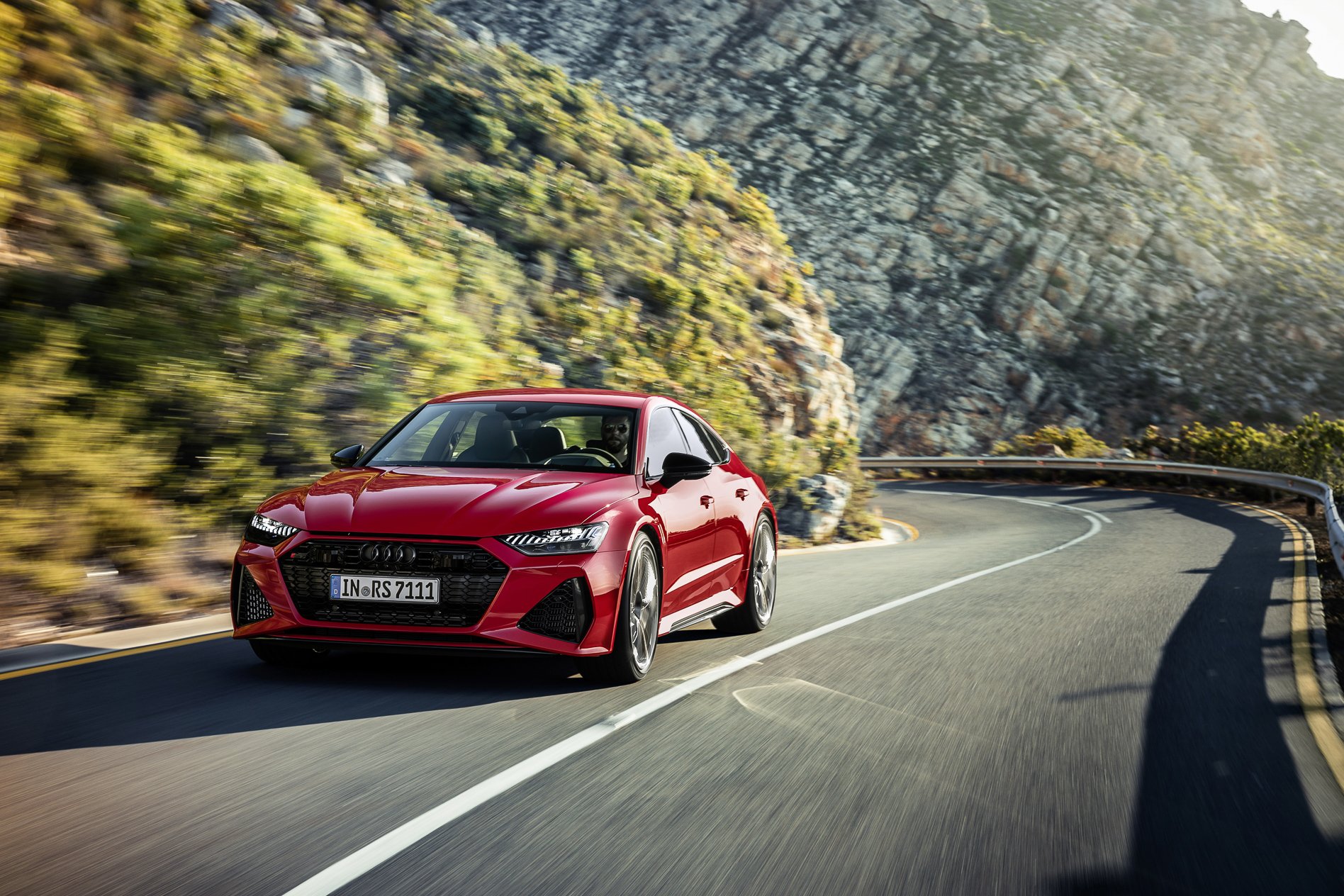
Rear-wheel steering is particularly influential in the transformation, allowing the big Sportback to rotate as a shorter sportscar would. Also worth praise is the RS transmission program that favours the rear axle for power until the person at the wheel runs out of talent.
Tap the new RS button on the steering wheel, however, and the RS7 goes from extra spicy to nuclear. Turbo lag is nonexistent and the mid-range torque is stupendous, but thanks to proprietary quattro smarts, the power can be applied mid-corner, firing the Audi from one corner to the next.
The previously slick automatic – one of the most seamless we’ve experienced – switches into an aggressive map and is beautifully intuitive when left to its own devices, and grabbing for the shift paddles was hardly ever necessary.
When you do though, the gearbox will allow you to downshift into the red – a great statement of intent that this is a true performance model.
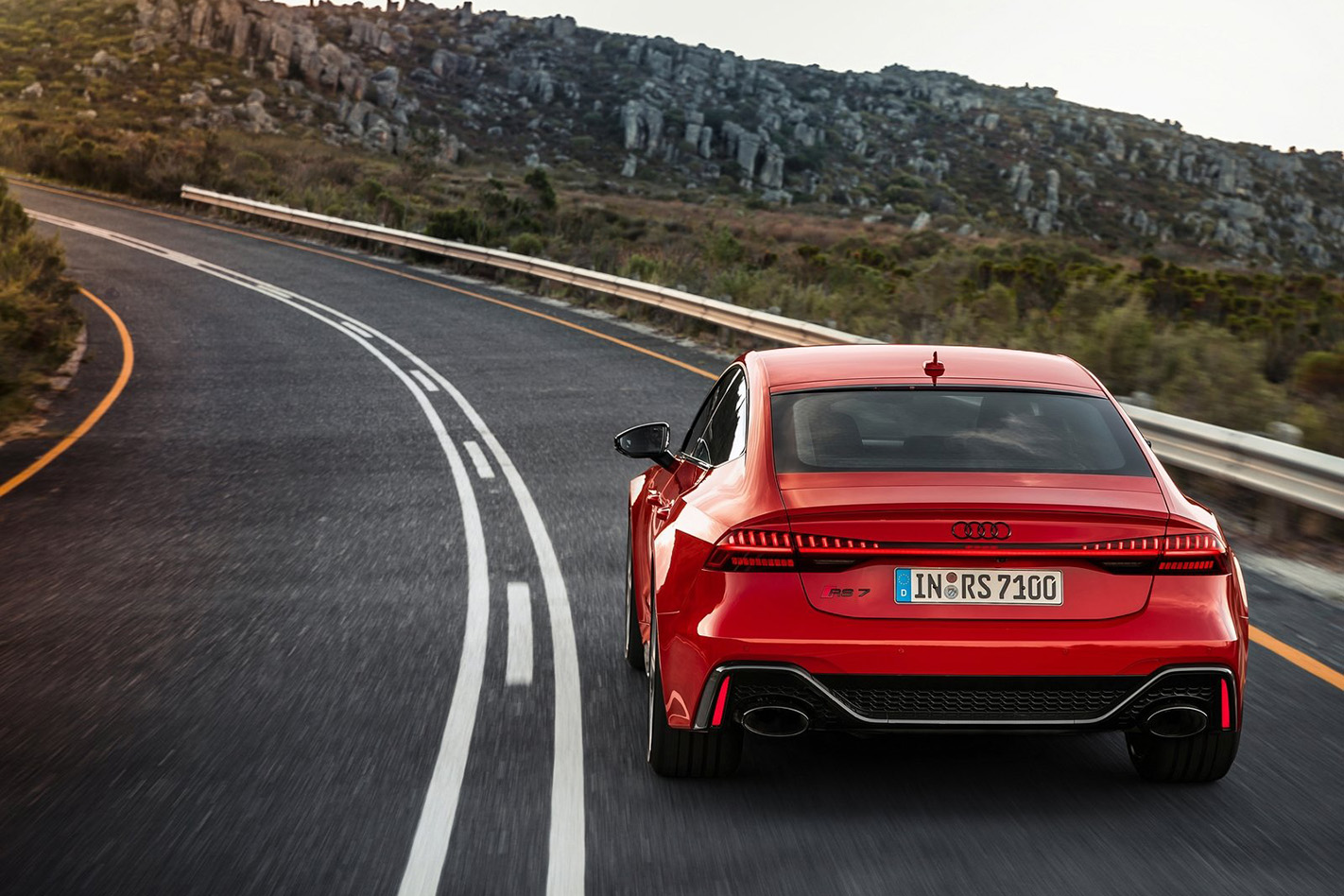
Air suspension is available for those that want the best option for ride comfort but, for our money, the ‘standard’ RS Sport set up is the pick for getting the most in the corners. It’s not exactly uncomfortable cruising either. Unlike the previous RS7, both suspension options are rated for the full 305km/h v-max.
Our desire for a little more shout from the massive tailpipes is just about our only criticism and the new version doesn’t seem to quite equal the first-gen RS7’s gloriously antisocial report.
It’s not the larrikin that the BMW M5 is nor is it as switched-on as the borderline neurotic Mercedes-AMG E63. But in a fight between the big three German ‘sedans’ It is, without doubt, the easiest to live with and therein lies the genius in Audi’s approach. The RS7 doesn’t try to beat the M5 at its own game, instead pursuing its own ambition to be genuinely useable day to day.
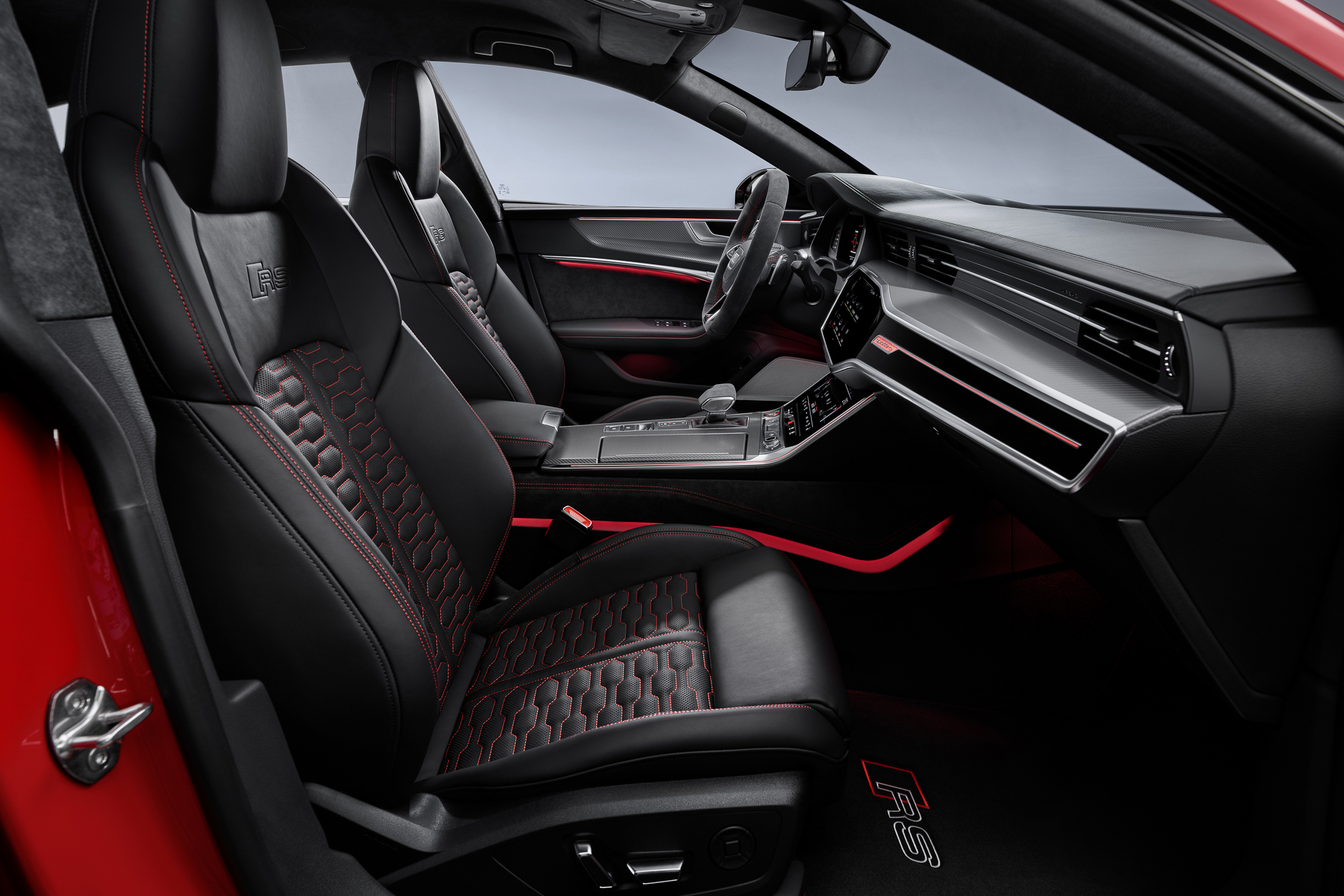
In the second row, tall adults have plenty of space and there’s even enough headroom despite the diving roofline. Behind that, there’s a huge boot, which couldn’t be any easier to access courtesy of the unique hatch.
It is not unkind to describe the Audi as relatively benign because, after a few hours of being pummelled by the Merc’s granite ride, that’s exactly what you’ll be craving.
After a day tearing up a decades-old German road race, the RS7 plots a course back to the Autobahn and provides a deeply relaxing method of getting where you need in comfort… and very, very fast.
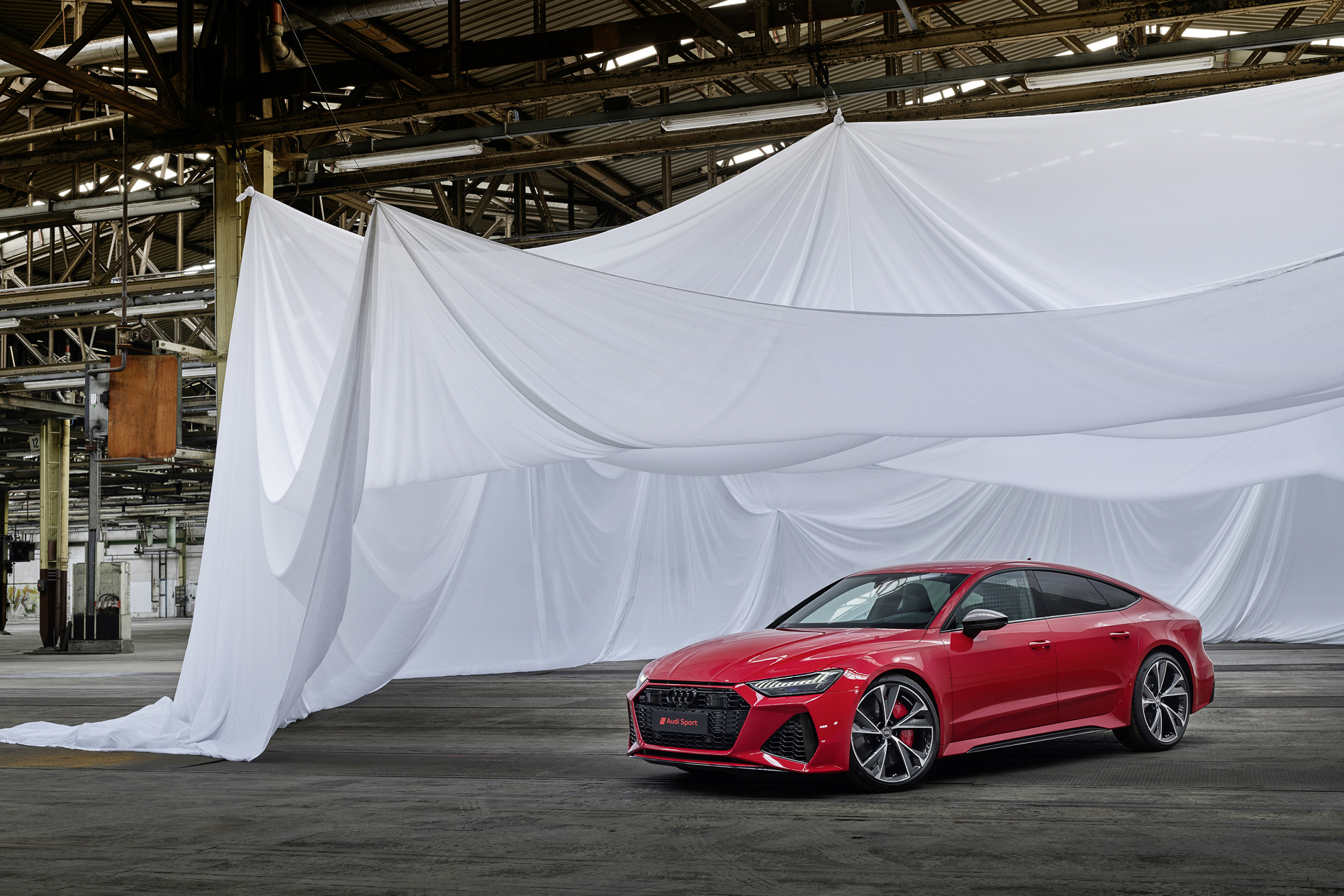
The hardest question to answer is whether you would pick the Sportback or the wonderfully unapologetic RS6 Avant. For our money, the added space of a wagon and the laughable implication that you might have actually bought it for its practicality is too tempting to resist.
Realistically though, both are obscenely complete vehicles offering their own individual practicality but the same monumental powertrain.
Second Opinion – MOTOR first drive
The new RS7 is the first Audi sport four-door in years that properly stirs the emotions By: Georg Kacher
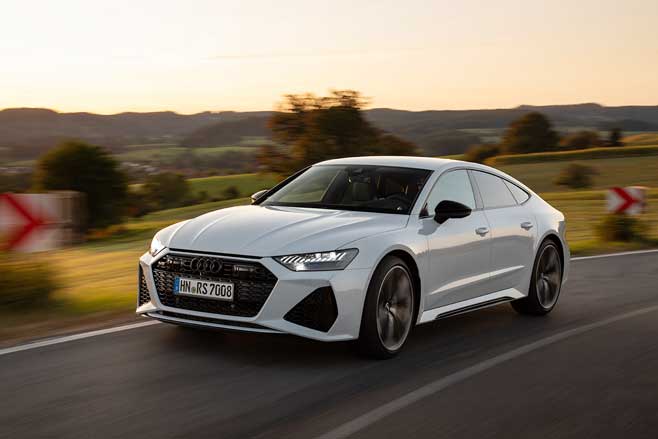
THE VERY FIRST Audi RS4 Avant was a real eye-opener, and so was the second-generation RS6 and of course every single iteration of the R8. But somewhere along the way, too soon and with almost tragic persistence, Audi’s in-house go-faster department lost the plot.
Sure, the cars engineered in Ingolstadt and produced in Heilbronn gained more power and torque with every model change, dedicated tech-heads got their money’s worth out of the increasingly ambitious interpretations of the Vorsprung durch Technik theme, and the more and more colourful make-up kept boosting the poseur value. But drive a 2018 model RS5 or RS6 and you will very likely be anaesthetised by the duff steering, wooden brakes, muffled feedback even close to the limit, and the frustrating artificial supremacy of the safe but stubborn electronic control apparatus.
To add insult to injury, the engines began to lose their lustre when the normally aspirated V8 gave way to the breathless turbocharged V6, the V10 was put on the list of endangered species for good, and the evolution of the charismatic five-cylinder ended in a bloody boardroom battle.
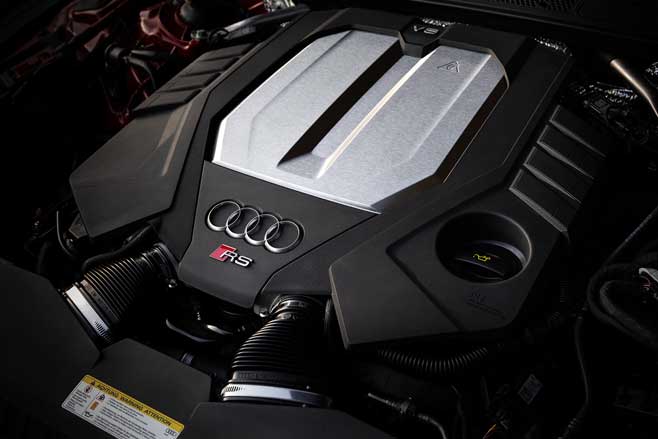
In view of this patchy historic background, hopes were not high when Audi invited us to sample the second-generation RS7, which looks from some angles as if a Tonka Toys designer has been moonlighting under the influence. Marketing may disagree, but an optional stealth kit would do well with those who prefer to keep a low profile.
Thanks to the more emphatically flared Quattro-style wings, the 2020 vintage is 40mm wider than the outgoing model and the bulging wheelarches are now easily big enough to accommodate the optional 22-inch rims, which look the business but are bound to shatter the ride. The motorised spoiler that automatically extends at 100km/h is again part of the package, yet even when fully extended it cannot quite neutralise the rear axle lift pegged at 40 kilos at Vmax.
Available in Europe from €121,000 (AU$196,000) and due in Australia in April at an estimated $250K, Audi’s top-of-the-line five-door coupe takes on, among others, the much more expensive Mercedes AMG GT4, upcoming BMW M8 Gran Coupe and even pricier Porsche Panamera Turbo. In terms of value for money, the competition is therefore giving Audi a head start.
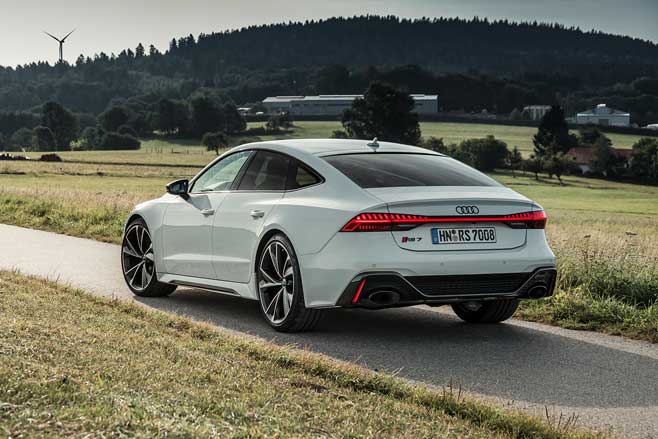
Performance-wise, it’s pretty much a dead-heat between the previous 445kW RS7 and its 441kW replacement. On the debit side, the fuel consumption has gone up by about 10 per cent due to comprehensive desmogging equipment – and, owing to the mandatory particulate filters, the mid-range full-throttle acceleration is now at least subjectively less explosive.
According to the data sheet, though, the new RS7 is in top form. Despite a 50kg weight increase, the four-seater (the rear middle seat costs extra) can roar from 0-100km/h in 3.6sec and cross the 200km/h barrier a mere 8.4sec later. That’s supercar quick and totally repeatable regardless of weather conditions thanks to quattro four-wheel drive.
The top speed depends on the customer’s budget. A bog standard RS7 is electronically limited to 250km/h, and while the available RS Dynamic package lifts the limit to 280km/h, the RS Plus kit, which throws in carbon-ceramic brakes, is good for an even ballsier 305km/h. Despite the standard mild-hybrid application, part-time cylinder on-demand system and a commendably slippery drag coefficient of 0.32, the average fuel consumption works out at an unremarkable 11.6L/100km. No, you don’t want to know…
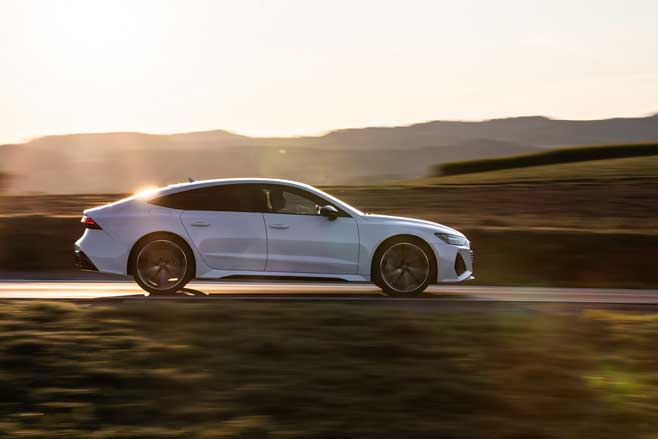
But enough foreplay. Now it’s crunch time, first on the autobahn from Frankfurt to Basel, then on the back roads of the Odenwald where fox and hare bid each other good night.
Hit the starter button and the engine instantly lapses into a scantily muffled version of ‘love thy neighbours’. Although the Comfort volume is loud enough to make next door’s poodle prick his ears, the composer of the RS7 soundtrack has provided a much rowdier on-demand exhaust symphony. If you’re an almost-deaf heavy metal supporter, then go ahead and treat yourself to the extra-cost sports exhaust, which is so damned noisy it will soon be black-flagged by the EPA anyway.
Despite these and other frivolities, the high-tech Audi is emphatic proof that the days when driving a motor car was a simple clutch-shift-throttle-brake sequence are definitely over. For a start, the spy in the cab keeps bugging you to select from four basic programs named Auto, Comfort, Efficiency and Dynamic. Sounds straightforward but isn’t because next on the to-do list are mandatory individual calibrations of engine, transmission, dampers… the whole caboodle. Last but not least, you must define the preferred composition of the dynamic RS1 and RS2 modes to be accessed later by the accordingly marked steering-wheel button.

The RS7 comes at this point with only one engine specification – a more potent Plus version may follow in due course – but the buyer can choose between two different chassis configurations at no charge. Option one is the RS adaptive air suspension, option two is the RS sport suspension paired with Dynamic Ride Control (DRC). We drove both versions, and walked away equally impressed.
Owners who take their car to the track at least occasionally, get a kick out of making backroad hell freeze over on early Sunday mornings, and typically need a fresh set of tyres every six to nine months should specify the second option. What makes this choice special is the instant yaw, roll and pitch control executed by conventional steel springs and diagonally connected adaptive shock absorbers. It’s an ancient yet still compelling system first introduced by Citroen in the DS and later made standard by Audi in the 2005 RS4.
DRC provides a totally flat ride and a steadfast cornering stability irrespective of the surface quality. At the same time, this performance-oriented chassis will talk you through bend after bend by feeding relevant information and filtering out interference.
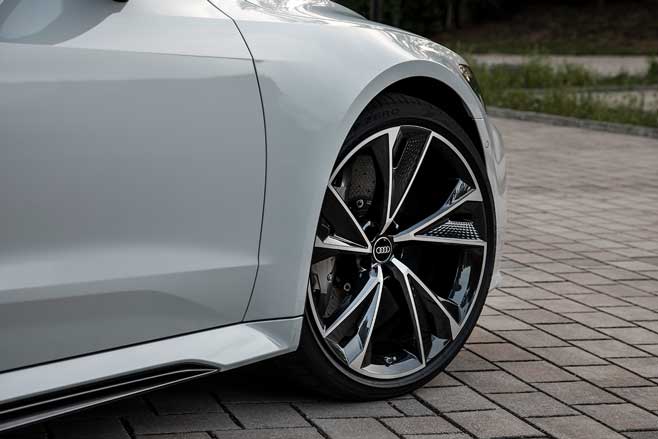
Although the latest iteration of the RS air suspension is 50 per cent stiffer than in a no-frills A7, the ride in Comfort mode is somewhat cushier than in a car fitted with the less compliant steel set-up. Another bonus is the air cushion’s ability to lower the body height by 10mm above 120km/h and to raise it by 20mm before tackling tall obstacles like speed humps and angled driveways.
So, no contest? It really depends on individual priorities and preference. The air suspension has the edge in terms of ultimate directional stability assistance, and it offers a relatively broad adjustment range, while the largely analogue DRC system is more communicative, more linear and more rewarding when you feel like having a really wild time.
In contrast to the previous RS7, which was rather harsh and unrefined when pushed, both versions contribute to the much improved composure, suppleness and ground contact. The notably less erratic low-speed ride over manhole covers and hotchpotch tarmac also deserves a favourable mention, as does the near total absence of brake dive and acceleration squat.
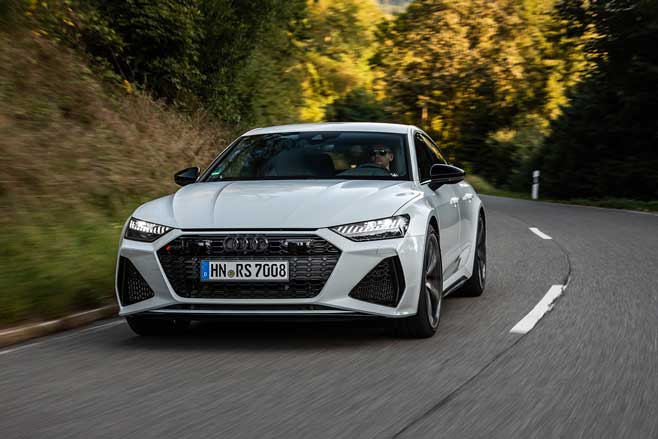
Extra money buys the useful rear-wheel steering, which reduces the turning circle by a full metre while consolidating the directional stability at speed. Another option worth contemplating are the unflagging carbon-ceramic brakes, not only due to their enormous stopping power but also because of the constant pedal pressure and travel, and their immunity to fading.
Full marks also for the reprogrammed electro-mechanical steering, which in its latest metamorphosis is keen to communicate, share information and filter disruptive elements while still relaying essential warning signals, arising grip issues and any pending change of handling balance. The difference between old and new in this department really is night-and-day drastic, especially when you wind on lock; the ratio quickens accordingly and the action becomes instantly more direct. Nice.
Although traction is rarely an issue, the torque distribution has been redefined for more pliable handling, quicker feedback at the limit and higher cornering speeds. Depending on the Drive Select set-up and the chosen RS1/RS2 preferences, the black box can now send up to 70 per cent of the car’s 800Nm to the front axle and up to 85 per cent of the momentum to the rear wheels, where the optional quattro sport differential will mastermind the side-to-side torque split.
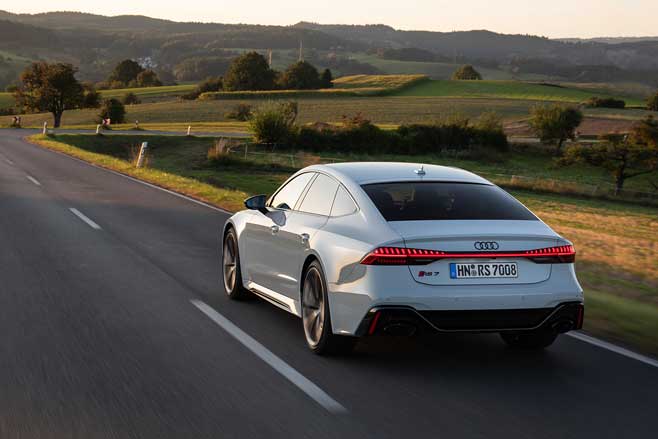
The 4.0-litre V8 produces its peak power output between 6000 and 6250rpm. The maximum twist action is on tap from 2050 to 4500rpm, so high revs are not an obvious forte of this engine. Even though there’s no turbo lag worth mentioning, the throttle response scores only 8.5 on the 10-point hooligan scale, and the mild hybrid module has no instantly obvious energy-saving effect.
The compact E-unit can recuperate up to 21kW of brake energy, which is instantly redirected to the buffer battery or used to power the air-conditioning and the auxiliary equipment. The more radical stop-start system cuts the engine as soon as road speed drops below 22km/h. At the same time, it enables lift-off coasting between 55 and 160km/h as long as Drive Select has been pre-set in Efficiency.
Just about any kind of information you can think of – from the status of more than 30 assistance systems to the megabyte music library – is relayed real-time by the elaborate multi-panel, multi-display MMI touch-response complex.
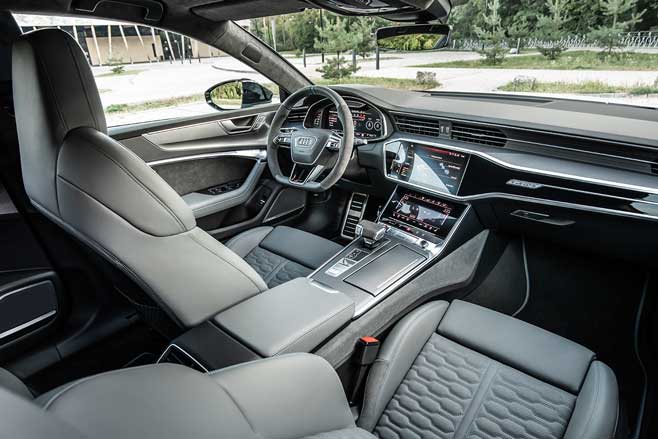
Although the black box behind this elaborate orchestration is probably intelligent enough to back horses, we like the complex layout best when the focus is on the RS monitor, which features the prominent technicolour upshift blitz, fist-size speedometer, large gear indicator and supplementary readouts detailing g-force, temperatures, tyre pressures and charge air flow.
If the new RS7 does define the shape of things to come from Audi Sport, the Ingolstadt powerbrokers have finally come to grips with their worst legacies by making outstanding performance much more transparent and accessible. In addition to ample grunt and reassuring surefootedness, excitement and emotion are about to return as integral parts of the RS DNA.
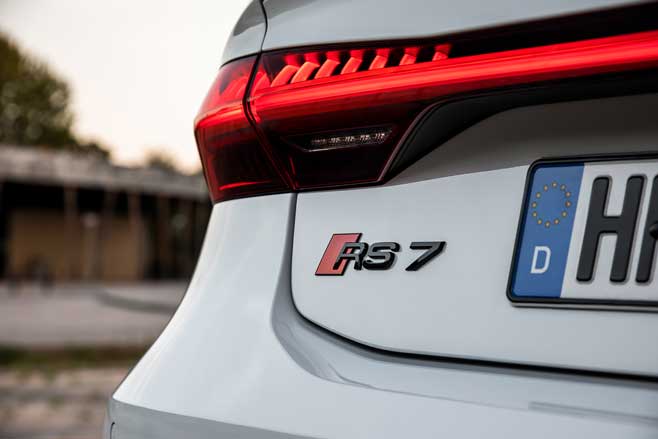
FAST FACTS 2019 Audi RS7 BODY: 2-door, 4-seat coupe DRIVE: all-wheel ENGINE: 3993cc V8, DOHC, 32v, twin turbo BORE/STROKE: 84.5 x 89.0mm COMPRESSION: 10.0:1 POWER: 441kW @ 6000rpm TORQUE: 800Nm @ 2050-4500rpm WEIGHT: 2065kg POWER-TO-WEIGHT: 244kW/tonne TRANSMISSION: 8-speed automatic SUSPENSION: five-link, adaptive dampers, air or coil springs, anti-roll bar (f/r) L/W/h: 5009/1950/1402mm WHEELBASE: 2929mm TRACKS: 1668/1650mm (f/r) STEERING: electrically assisted rack-and-pinion BRAKES: 420mm ventilated/drilled discs, 10-piston calipers (f); 370mm ventilated/drilled discs, single-piston calipers (r) WHEELS: 21.0 x 10.5-inch TYRES: Pirelli P Zero (AO), 275/35 ZR21 (f/r) PRICE: $250,000 (est)
PROS: Mind-bending performance; transformed chassis CONS: Overweight; complex drive modes; divisive face
RATING: 4.5 out of 5 stars




